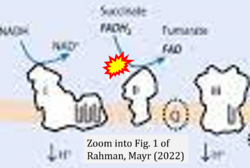Rahman 2022 Springer
| Rahman S, Mayr JA (2022) Disorders of oxidative phosphorylation. In: Saudubray JM, Baumgartner MR, García-Cazorla Á, Walter J (eds) Inborn metabolic diseases. Springer, Berlin, Heidelberg. https://doi.org/10.1007/978-3-662-63123-2_10. |
Rahman S, Mayr JA (2022) Springer, Berlin, Heidelberg
Abstract: Disorders of oxidative phosphorylation encompass heterogeneous infantile, childhood and adult onset diseases characterised by variable involvement of high energy requiring organs. The central and peripheral nervous systems, skeletal and cardiac muscle, eyes, ears, kidneys and liver are frequently involved. Some well-characterised mitochondrial syndromes are recognised, but many patients have overlapping features not corresponding to a specific syndrome. Theoretically any organ or tissue or combination of organs may be affected, with onset at any age. Owing to the involvement of two distinct genomes, the nuclear genome and that located within the mitochondrion itself, a range of modes of inheritance of mitochondrial disease has been observed: maternal (mitochondrial DNA), autosomal recessive, autosomal dominant, X-linked and sporadic. Disease mechanisms include mutations affecting OXPHOS subunits and assembly factors, and disorders of mitochondrial DNA maintenance, protein synthesis, cofactor biosynthesis and lipid metabolism. Mitochondrial trafficking and organelle communication at membrane contact sites are discussed in chapter 44. The complexity of underlying disease mechanisms, together with clinical, biochemical and genetic heterogeneity, creates enormous diagnostic challenges. Most mitochondrial diseases, especially childhood-onset forms, are characterised by relentless progression. Specific treatments are available for some extremely rare forms of mitochondrial disease, but the majority of cases lack curative treatments, and the mainstay of treatment is supportive.
• Bioblast editor: Gnaiger E
Correction: FADH2 and Complex II
- FADH2 is shown as the substrate feeding electrons into Complex II (CII). This is wrong and requires correction - for details see Gnaiger (2024).
- Gnaiger E (2024) Complex II ambiguities ― FADH2 in the electron transfer system. J Biol Chem 300:105470. https://doi.org/10.1016/j.jbc.2023.105470 - »Bioblast link«


